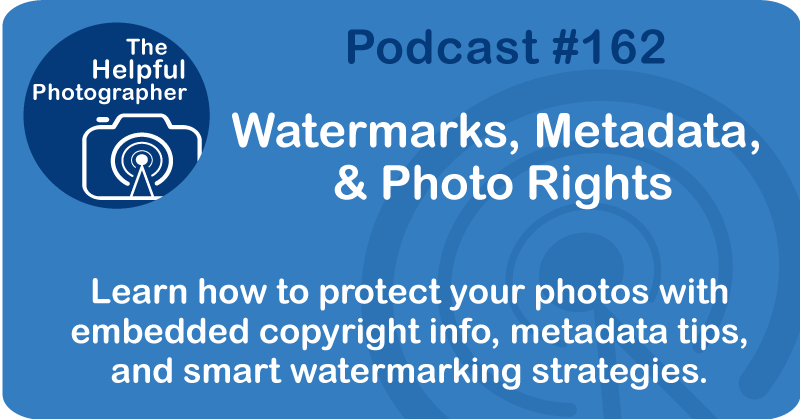Watermarks, Metadata, & Photo Rights #162

I'm Zim and you're listening to the Helpful Photographer Podcast in collaboration with Boundless Photo Safari. To register for a safari, please visit BoundlessPhotoSafari.com.
Today I'm diving into a great question from Vicki in Tulsa, Oklahoma. Welcome back, Vicki. Always happy to hear from you. She asked about adding copyright information to images. This is a really great topic, especially for anyone sharing their work online. So is it a good idea to embed copyright info into your photos? Absolutely. Why not? I don't see a downside to it. And if I were to check in with my intellectual property lawyer, I'm pretty sure he'd agree.
So let's start with the easiest option. Do it right in your camera. Most cameras today let you add basic copyright details like your name and contact information. It's usually buried somewhere in the settings menu. It's often called copyright info. Imagine that. Once it's set, it gets embedded into every photo you take so you don't have to think about it again. And for anyone wondering, yes,
while that embedded information can be stripped out by someone who really knows what they're doing, the average person has no idea that it's even there. Never mind how to get rid of it. So by adding it in camera, you're adding a solid layer of protection right from the start. So let's say you didn't do it in camera. That's okay, you can do it in Lightroom. When you're importing your images, there's a panel on the right side called Apply During Import.
Just click on that, then head to the Metadata section and choose Edit Presets. Here you can add a custom preset with all of your info—name, email, website, and of course a copyright notice. Just save that and then any time you import photos, boom, it's applied automatically. Forgot to do it on import? No worries. You can still add copyright data later in the Library module. Go to the Library module,
open the Metadata panel on the right side, switch to the EXIF and IPTC view, and either fill in the fields manually or apply one of your saved presets. And if you've got a whole bunch of photos, just apply it to one, select the rest, and hit Sync. Not Sync Settings—just Sync. And check the Metadata box in the pop-up. Done and done. Now let's talk about the other kind of copyright notices, like a watermark.
You know, the kind people can actually see on the image itself. You know, something like Jane Doe Photography with a copyright symbol next to it. Is that a good idea? Well, it depends. From a marketing standpoint, yeah, it's a great idea. You're putting your name out there, giving people a way to find you and letting them know who created the image. I think that's smart. From a theft standpoint, let's be honest. If someone really wants to steal your photo, they probably will.
The internet is what it is. You can try to block downloads on your website, but there are ways around pretty much all of that. That said, watermarking does help. It tells people, this isn't free to use—but please keep it tasteful. I've seen watermarks so huge that it's difficult to see the photo behind it. That's when you have to ask yourself, why are you posting this image? If it's there to share your art,
show off your skills, or attract clients, don't bury it under a watermark because people won't see any of that. They're just gonna see a watermark. So what's the best strategy? Here's my take. Embed the copyright into your image data or during import. Use a watermark if it makes sense for your goals, but keep it subtle. Don't let it distract from your work. If you've got a truly valuable marketable image,
get it into a reputable stock site or register the copyright properly so you can actually enforce your rights. And please, don't skip the last part. If you haven't registered your copyright and someone rips off your photo, your legal options are pretty limited. You can still go after them, but it's a much tougher road. For more copyright information, check out episodes 36 and 37, where I talk with my IP lawyer, Michael Cukor.
So there you go. Vicki, I hope that helps. And thanks again for sending in another great question. And for those of you who also have questions, feel free to send me an email: [email protected]. Until next time, keep on shooting.










